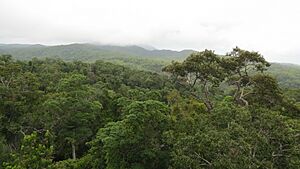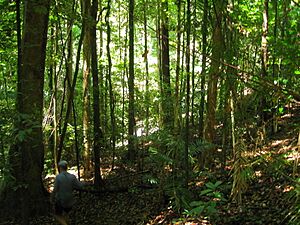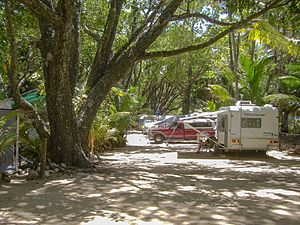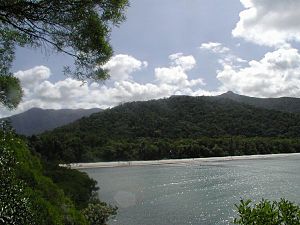Daintree Rainforest facts for kids
The Daintree Rainforest, often called just the Daintree, is a special place on the northeastern coast of Queensland, Australia. It's about 105 kilometers (65 miles) north of the city of Cairns. When people talk about the Daintree, they usually mean the area from the Daintree River up to Cooktown. This area stretches from the coastline west to the Great Dividing Range. Even Mossman Gorge, a popular spot about 30 kilometers (19 miles) south of the Daintree River, is often included.
This amazing rainforest covers about 1,200 square kilometers (460 sq mi). It's part of the largest tropical rainforest area in Australia, known as the Wet Tropics of Queensland. The Daintree is one of the oldest rainforests still existing in the world! It's around 180 million years old, which is almost 10 million years older than the Amazon Rainforest in South America. Imagine, these ancient forests have seen dinosaurs, ice ages, and early humans come and go!
In 2009, the Daintree Rainforest was recognized as one of Queensland's top "natural attractions" during the state's Q150 celebrations.
Contents
Discovering the Ancient Daintree Rainforest
A Living History of Nature
The Daintree Rainforest gets its name from the Daintree River. The river itself was named after Richard Daintree (1832–1878), an Australian geologist and photographer. This rainforest is a small piece of what was once a huge forest covering the entire Australian continent. It's a rare survivor, having lasted through 120 million years of changing climates and continental drift. This process slowly moved continents, shrinking the original vast forest to just a few special areas on Australia's east coast.
Protecting a Natural Treasure
The Daintree area includes the Daintree National Park, some state-owned forests, and private land where people live. To protect this special place, the government has been buying back some of the private land. This helps make sure more of the rainforest is preserved for everyone. As of May 2011, many properties were secured for conservation. This effort involved the Queensland Parks and Wildlife Service and private groups working together.
On September 29, 2021, a very important event happened. The Kuku Yalanji people, who are the traditional owners of this land, officially gained ownership of a huge area. This land stretches from Mossman to Cooktown and includes the Daintree National Park. This historic agreement recognized their deep connection to the land.
Amazing Plants and Animals
The Daintree Rainforest is bursting with life! It has about 3,000 different plant species from nearly 210 plant families. There are over 900 different types of trees. In just one small area, you might find 100 to 150 unique plant species!
This forest is home to many Australian animals. It has 30% of all frog, reptile, and marsupial species in Australia. It also hosts 90% of the continent's bat and butterfly species. About 7% of Australia's bird species live here. Plus, there are over 12,000 kinds of insects, along with countless smaller animals, fungi, and mosses. All this incredible life is packed into an area that is only 0.12% of Australia's landmass!
Part of the forest is protected within the Daintree National Park. The Daintree River flows through it. The roads north of the river are carefully designed to have the smallest possible impact on this ancient ecosystem.
Exploring the Daintree's Wonders
The Daintree region offers a unique mix of experiences. You can find lush tropical rainforests, beautiful white sandy beaches, and coral reefs just offshore. This combination is very rare in the world! Since attractions are spread out, driving is often the easiest way to see everything. The Daintree National Park has many walking tracks. You can also find places to stay right inside the rainforest.
West of Cape Tribulation, you'll see Mt Pieter Botte with its huge granite rocks. From the top, you get amazing views of the untouched forest. To the south, Thornton Peak, one of Queensland's tallest mountains, stands out with its giant granite boulders.
A World Heritage Site
Much of the Daintree Rainforest is part of the Wet Tropics of Queensland World Heritage Site. UNESCO listed it in 1988 because of its incredible natural value. People worked hard to protect this area. There were campaigns in the 1980s that helped secure its special status.
The Australian Government highlighted several reasons why the Daintree Rainforest, as part of the Wet Tropics, is so important:
- A Window into Earth's Past: The rainforest preserves major parts of Earth's evolutionary history. It has ancient plants that are like living fossils. These include some of the earliest land plants, ancient ferns, and cycads. There are also ancient conifers, like the kauri and hoop pines, which are similar to trees from the Jurassic age (the time of dinosaurs!). The Daintree also contains 12 primitive flowering plant families. These plants show us how flowering plants developed over millions of years. They connect us to the ancient supercontinent of Gondwana.
- Stunning Natural Beauty: The Daintree offers unique and beautiful natural sights. It has amazing coastal scenery where the tropical rainforest meets white sandy beaches, with coral reefs just offshore. You can also find rugged mountain peaks, deep gorges with fast-flowing rivers, and spectacular waterfalls, like those at Mossman Gorge. The vast views of undisturbed forest and valleys are truly breathtaking.
Home to Rare Species
The Daintree Rainforest is a vital habitat for many different kinds of life. About 430 species of birds live among its trees. Some unique plants, like Austrobaileya scandens and Idiospermum australiense, are found only here. The Daintree is also home to several rare and endangered animals. These include the magnificent southern cassowary (Casuarius Casuarius) and the adorable Bennett's tree-kangaroo (Dendrolagus bennettianus).
Daintree Important Bird Area
This special area, known as the Daintree Important Bird Area (IBA), covers about 2,656 square kilometers (1,025 sq mi). It mostly includes the northern part of the Wet Tropics of Queensland. Several national parks are within or overlap with this area, such as Kalkajaka National Park, Ngalba Bulal National Park, Daintree National Park, Mount Windsor National Park, and Mowbray National Park.
BirdLife International has identified this as an IBA because it supports a healthy population of southern cassowary birds. It's also home to many other unique birds. These include the tooth-billed and golden bowerbirds, lovely fairywrens, and several types of honeyeaters. You can also find fernwrens, Atherton scrubwrens, mountain thornbills, chowchillas, Bower's shrike-thrushes, pied monarchs, Victoria's riflebirds, and pale-yellow robins here.
See also
- Cape York Peninsula
- Forests of Australia
- Queensland tropical rain forests





